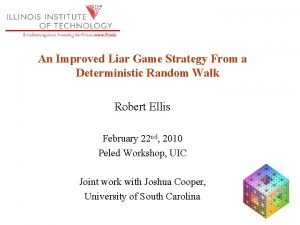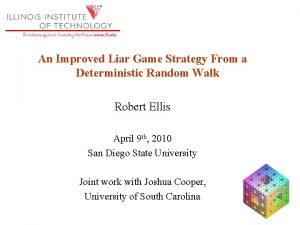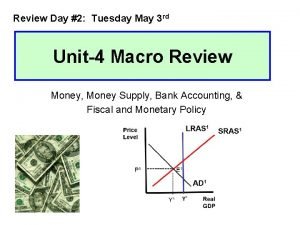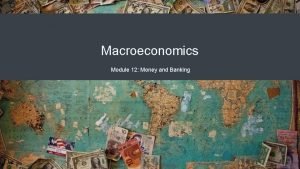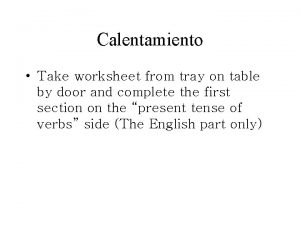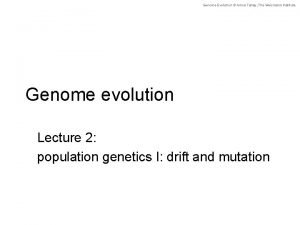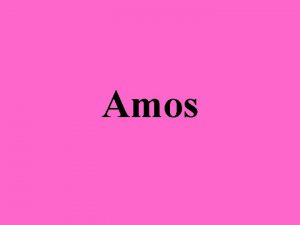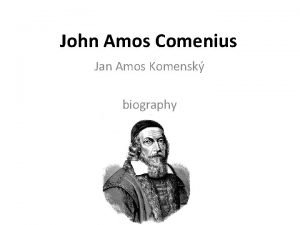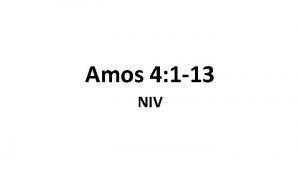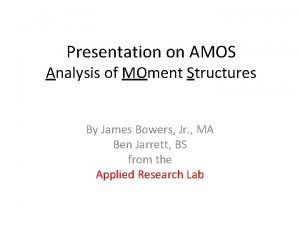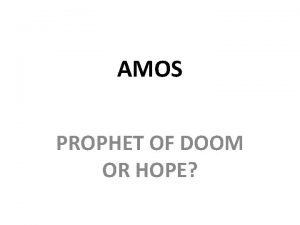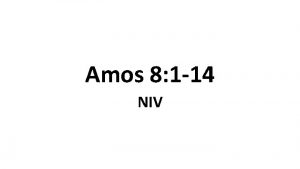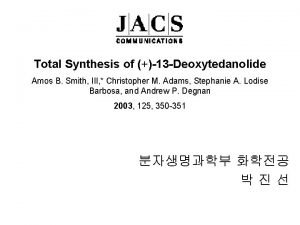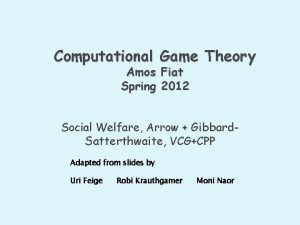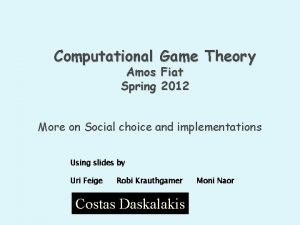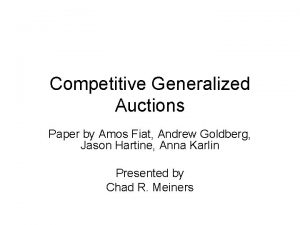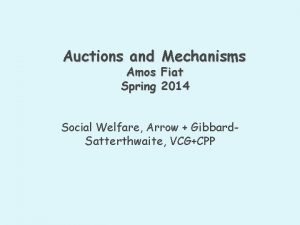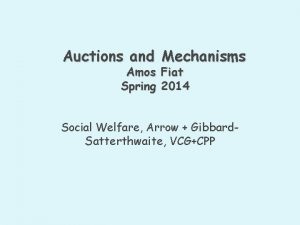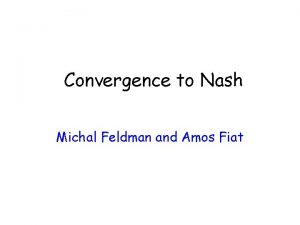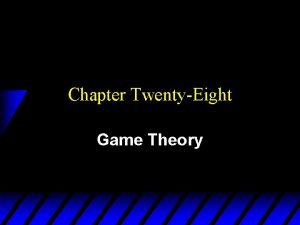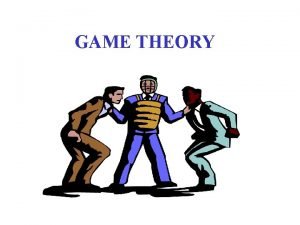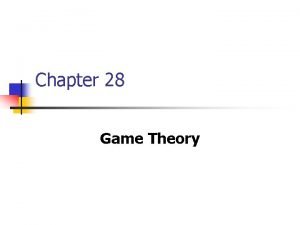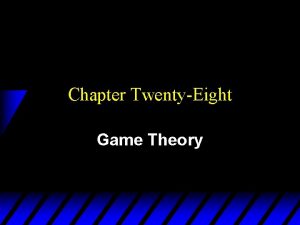Computational Game Theory Amos Fiat Modified Slides prepared




























































![History + Generalizations � model, � Nash defn of Nash flows by [Wardrop 52] History + Generalizations � model, � Nash defn of Nash flows by [Wardrop 52]](https://slidetodoc.com/presentation_image_h2/66534236b9954017292cf524564abe34/image-61.jpg)







- Slides: 68

Computational Game Theory Amos Fiat Modified Slides prepared for Yishay Mansour’s class Lecture 1 - Introduction 1

Agenda � Introduction � Examples � Matrix � Utility to Game Theory form Games � Solution concepts � Dominant Strategies � Nash Equilibria � Complexity � Mechanism Design: reverse game theory 2

Computational Game Theory � The study of Game Theory in the context of Computer Science, in order to reason about problems from the perspective of computability and algorithm design. 3

CGT in Computer Science � Computing involves many different selfish entities. Thus involves game theory. � The Internet, Intranet, etc. ◦ Many players (end-users, ISVs, Infrastructure Providers) ◦ Players wish to maximize their own benefit and act accordingly ◦ The trick is to design a system where it’s beneficial for the player to follow the rules 4

CGT in Computer Science � Theory ◦ Algorithm design ◦ Complexity ◦ Quality of game states (Equilibrium states in particular) ◦ Study of dynamics � Industry ◦ Sponsored search ◦ Other auctions 5

Game Theory � Rational Player ◦ Prioritizes possible actions according to utility or cost ◦ Strives to maximize utility or to minimize cost � Competitive Environment ◦ More than one player at the same time Game Theory analyzes how rational players behave in competitive environments 6

The Prisoner’s Dilema � Matrix representation of the game Thieves honor Defect Thieves honor 3, 3 6, 2 2<3 Defect 2, 6 5, 5 5<6 Row Player Column Player 7

The Prisoner’s Dilema � It is a dominant strategy to confess � A dominant strategy is a “solution concept” Thieves honor Defect Thieves honor 3, 3 6, 2 Defect 2, 6 5, 5 6, 10 8

ISP Routing � Internet Service Providers (ISP) often share their physical networks for free � In some cases an ISP can either choose to route traffic in its own network or via a partner network 9

ISP Routing � ISP 1 needs to route traffic from s 1 to t 1 2 needs to route traffic from s 2 to t 2 � The cost of routing along each edge is one A B 10

ISP Routing � ISP 1 routes via B: ◦ Cost for ISP 1: 1 ◦ Cost for ISP 2: 4 11

B, A: s 21 to to tt 12 ISP Routing � Cost matrix for the game: ISP 2 ISP 1 A B A 3, 3 6, 2 B 2, 6 5, 5 Prisoners Dilemma Again 12

Strategic Games � The game consists of only one ‘turn’ � All the players play simultaneously and are unaware of what the other players do � Players benefit are selfish, seek to maximize their own 13

Strategic Games – Formal Model �N = {1, …, n} players � Player i has actions We will say “action” or “strategy” � The space of all possible action vectors is �A joint action is the vector a∈A � Player i has a utility function If utility is negative we may call it cost 14

Strategic Games – Formal Model �A strategic game: Players Actions of each player Utility of each player 15

Dominant Strategies � Action ai of player i is a weakly dominant strategy if: Action ai of player i is a strongly dominant strategy if: 16

Pareto Optimality Vilfredo Pareto � An outcome a of a game is Pareto optimal if for every other outcome b, some player will lose by changing to b 17

Bernulli Utility St. Petersburg Paradox: ◦ Toss a coin until tails, I pay you ◦ What will you pay me to play? “Utility of Money”, “Bernulli Utility” 18

Von Neumann–Morgenstern Rationality Axioms (1944) Preferences over lotteries Completeness: Transitivity: Continuity: Independence: 19

Rationality Axioms Utility function over lotteries, real valued, expected utility maximization 20

Allias Paradox (1953) Gamble A: 100% Gamble B: 10% 89% 1% € 1, 000 € 5, 000 € 1, 000 Nothing Gamble C: 11% 89% Gamble D: 10% 90% € 1, 000 Nothing € 5, 000 Nothing Gamble A or B? Experimental ”Fact”: Gamble C or D? Experimental “Fact”: 21

Allias Paradox Gamble A: 100% Gamble B: 10% 89% 1% € 1, 000 € 5, 000 € 1, 000 Nothing Gamble C: 11% 89% Gamble D: 10% 90% € 1, 000 Nothing € 5, 000 Nothing “Fact”: 22

Expected Utility Theory VNM Axioms Expected Utility Maximization Mixed Nash Equilibrium exists 23

Tragedy of the commons � Assume there’s a shared resource (network bandwidth) and N players. � Each player “uses” the common resource, by choosing Xi from [0, 1]. If Otherwise, 24

Tragedy of the commons Given that the other players are fixed, what Is the best response? 25

Tragedy of the commons This is an equilibrium No player can improve 26

Tragedy of the commons The case for Privatization or central control of commons 27

Nash Equilibrium �A Nash Equilibrium is an outcome of the game in which no player can improve its utility alone: � Alternative definition: every player’s action is a best response: 28

Battle of the Sexes � The payoff matrix: 29

Battle of the Sexes � The payoff matrix: Row player has no incentive to move up 30

Battle of the Sexes � The payoff matrix: Column player has no incentive to move left 31

Battle of the Sexes � The payoff matrix: So this is an Equilibrium state 32

Battle of the Sexes � The payoff matrix: Same thing here 33

Routing Game � 2 players need to send a packet from point O to the network. � They can send it via A (costs 1) or B (costs 2) 34

Routing Game � The cost matrix: 35

Routing Game � The cost matrix: Equilibrium states 36

Matching Pennies � 2 players, each chooses Head or Tail � Row player wins if they match the column player wins if they don’t � Utility matrix: 37

Matching Pennies � 2 players, each chooses Head or Tail � Row player wins if they match the column player wins if they don’t � Utility matrix: Row player is fine, but Column player wants to move left 38

Matching Pennies � 2 players, each chooses Head or Tail � Row player wins if they match the column player wins if they don’t � Utility matrix: Column player is fine, but Row player wants to move up 39

Matching Pennies � 2 players, each chooses Head or Tail � Row player wins if they match the column player wins if they don’t � Utility matrix: Row player is fine, but Column player wants to move right 40

Matching Pennies � 2 players, each chooses Head or Tail � Row player wins if they match the column player wins if they don’t � Utility matrix: Column player is fine, but Row player wants to move down 41

Matching Pennies � 2 players, each chooses Head or Tail � Row player wins if they match the column player wins if they don’t � Utility matrix: No equilibrium state! 42

Mixed Strategies � Players do not choose a pure strategy (one specific strategy) � Players choose a distribution over their possible pure strategies � For example: with probability p choose Heads, and with probability 1 -p choose Tails 43

Matching Pennies � Row player chooses Heads with probability p and Tails with probability 1 -p � Column player chooses Heads with probability q and Tails with probability 1 -q � Row plays Heads: � Row plays Tails: 44

Mixed Strategy � Each player selects where is the set of all possible distributions over Ai � An outcome of the game is the Joint Mixed Strategy � An outcome of the game is a Mixed Nash Equilibrium if for every player 45

Mixed Strategy � 2 nd definition of Mixed Nash Equilibrium: � Definition: � Property of Mixed Nash Equilibrium: 46

Rock Paper Scissors � No pure strategy Nash Equilibrium, only Mixed Nash Equilibrium, for mixed strategy (1/3, 1/3). 47

Location Game �N ice cream vendors are spread on the beach � Assume that the beach is the line [0, 1] � Each vendor chooses a location X i, which affects its utility (sales volume). � The utility for player i : X 0 = 0, Xn+1 = 1 48

Location Game � For N=2 we have a pure Nash Equilibrium: 0 1/2 1 No player wants to move since it will lose space � For N=3 no pure Nash Equilibrium: 0 1/2 1 The player in the middle always wants to move to improve its utility 49

Location Game � If instead of a line we will assume a circle, we will always have a pure Nash Equilibrium where every player is evenly distanced from each other: 50

Cournot Competition �N companies are producing the same product � Company I needs to choose its production volume, xi ≥ 0 � The price is determined based on the overall production volume, � Each company has a production cost: � The utility of company i is: 51

Cournot Competition � Case 1: Linear price, no production cost ◦ Utility: ◦ Pure Nash Equilibrium is reached at: 52

Cournot Competition � Case 2: Harmonic price, no production cost ◦ Company i’s utility: ◦ Companies have incentive to produce as much as they can – no pure or mixed Nash Equilibrium 53

Auction �n players wants to buy a single item which is on sale � Each player has a valuation for the product, � Assume WLOG that � Each player submits bid, , all players submit simultaneously. 54

Auction � Case 1: First price auction ◦ The player with the highest bid wins ◦ The price equals the bid ◦ 1 st Equilibrium is: �The first player needs to know the valuation of the second player – not practical ◦ 2 nd Equilibrium is: 55

Auction � Case 2: Second price auction: Vickrey Auction ◦ The player with the highest bid wins ◦ The price equals the second highest bid �No incentive to bid higher than one’s valuation - a player’s utility when it bids its valuation is at least as high than when it bids any other value �This mechanism encourages players to bid truthfully � Mechanism Design: reverse game theory – set up a game so that the equilibria has a desired property 56

Equilibrium Concepts no regret correlated eq mixed Nash pure Nash bestresponse dynamics 57

Traffic Flow: the Mathematical Model �a directed graph G = (V, E) � k source-destination pairs (s 1 , t 1), …, (sk , tk) � a rate (amount) ri of traffic from si to ti � for each edge e, a cost function ce( • ) ◦ assumed nonnegative, continuous, nondecreasing Example: (k, r=1) s 1 c(x)=x c(x)=1 Flow = ½ t 1 Flow = ½ 58

Routings of Traffic and Flows: � f. P = amount of traffic routed on si-ti path P � flow vector f routing of traffic s t Selfish routing: what are the equilibria? 59

Nash Flows Some assumptions: � agents small relative to network (nonatomic game) � want to minimize cost of their path Def: A flow is at Nash equilibrium (or is a Nash flow) if all flow is routed on min-cost paths [given current edge congestion] Example: s x 1 Flow =. 5 t Flow =. 5 s x 1 Flow = 1 t Flow = 0 60
![History Generalizations model Nash defn of Nash flows by Wardrop 52 History + Generalizations � model, � Nash defn of Nash flows by [Wardrop 52]](https://slidetodoc.com/presentation_image_h2/66534236b9954017292cf524564abe34/image-61.jpg)
History + Generalizations � model, � Nash defn of Nash flows by [Wardrop 52] flows exist, are (essentially) unique ◦ due to [Beckmann et al. 56] ◦ general nonatomic games: [Schmeidler 73] � congestion game (payoffs fn of # of players) ◦ defined for atomic games by [Rosenthal 73] ◦ previous focus: Nash eq in pure strategies exist � potential game (equilibria as optima) ◦ defined by [Monderer/Shapley 96] 61

The Cost of a Flow Def: the cost C(f) of flow f = sum of all costs incurred by traffic (avg cost × traffic rate) x s 1 ½ ½ t Cost = ½ • ½ +½ • 1 = ¾ 62

The Cost of a Flow Def: the cost C(f) of flow f = sum of all costs incurred by traffic (avg cost × traffic rate) x s 1 ½ ½ t s t Cost = ½ • ½ +½ • 1 = ¾ Formally: if c. P(f) = sum of costs of edges of P (w. r. t. the flow f), then: C(f) = P f. P • c. P(f) 63

Inefficiency of Nash Flows Note: Nash flows do not minimize the cost � observed informally by [Pigou 1920] x s 1 1 ½ t ½ + 0 • 1 = 1 of Nash flow = 1 • 1 � Cost of optimal (min-cost) flow = ½ • ½ +½ • 1 = ¾ � Cost � Price 0 of anarchy : = Nash/OPT ratio = 4/3 64

Braess’s Paradox Initial Network: s x 1 ½ ½ 1 x t cost = 1. 5 65

Braess’s Paradox Initial Network: s x 1 ½ ½ 1 x cost = 1. 5 Augmented Network: t s x 1 ½ ½ ½ 0 ½ 1 x t Now what? 66

Braess’s Paradox Initial Network: s ½ x 1 ½ ½ ½ 1 x cost = 1. 5 Augmented Network: t s x 1 0 1 x t cost = 2 67

Braess’s Paradox Initial Network: s ½ x 1 ½ ½ ½ 1 x cost = 1. 5 Augmented Network: t s x 1 0 1 x t cost = 2 All traffic incurs more cost! [Braess 68] � see also [Cohen/Horowitz 91], [Roughgarden 01] 68
 Amos fiat
Amos fiat A small child slides down the four frictionless slides
A small child slides down the four frictionless slides Energy release quick check
Energy release quick check The pirate game sheet
The pirate game sheet Game lab game theory
Game lab game theory Liar game game theory
Liar game game theory Liar game game theory
Liar game game theory Fiat prayer
Fiat prayer P0010 fiat 500
P0010 fiat 500 Fiat 500l pop boje
Fiat 500l pop boje Link-e-entry
Link-e-entry Fiat delft
Fiat delft Fiat doblo dpf regeneration procedure
Fiat doblo dpf regeneration procedure Test socjometryczny wzór
Test socjometryczny wzór What is fiat money
What is fiat money What is fiat money
What is fiat money Fiat money definition
Fiat money definition What is fiat currency
What is fiat currency Game theory and graph theory
Game theory and graph theory Vcio toolkit
Vcio toolkit Modified arrhenius theory
Modified arrhenius theory Busca lo bueno y no lo malo para que vivais
Busca lo bueno y no lo malo para que vivais Why does joe think janie is being ungrateful
Why does joe think janie is being ungrateful Ar conjugation chart
Ar conjugation chart Amos wang
Amos wang Amos pms
Amos pms Jan amos
Jan amos Bailey amos
Bailey amos Amós 3 3 matrimonios
Amós 3 3 matrimonios Jan amos
Jan amos Amos 8 11-12
Amos 8 11-12 O as a amos an
O as a amos an Amos paran
Amos paran Amos software tutorial
Amos software tutorial Amos 9
Amos 9 Amos 2:6-8
Amos 2:6-8 Amos 1:1-15
Amos 1:1-15 Profeta amos
Profeta amos Amos 7:7-9
Amos 7:7-9 Amos background
Amos background Kings of israel and judah good and bad chart
Kings of israel and judah good and bad chart Tabula rasa
Tabula rasa Profeta amos
Profeta amos Amos tanay
Amos tanay Profeta amos
Profeta amos Elias se burla de los profetas de baal
Elias se burla de los profetas de baal Cómo murieron los profetas de la biblia
Cómo murieron los profetas de la biblia Output amos tidak keluar
Output amos tidak keluar Amos klausner
Amos klausner Book of amos background
Book of amos background Kieran amos warwickshire
Kieran amos warwickshire Amoscal
Amoscal Pansofia comenius
Pansofia comenius Amos dexter
Amos dexter Amos rao
Amos rao Jeus 8
Jeus 8 Ezekiel, amos, isaiah, jeremiah
Ezekiel, amos, isaiah, jeremiah Amos 1 niv
Amos 1 niv Amos 2 4
Amos 2 4 Analysis of moment structures (amos)
Analysis of moment structures (amos) Pauliina margolis
Pauliina margolis Amos chin
Amos chin Simon amos beazley
Simon amos beazley Amos 8v9
Amos 8v9 Book of amos bible study
Book of amos bible study Amos prophet of doom
Amos prophet of doom Amos 8:1-14
Amos 8:1-14 Amos 6:12
Amos 6:12 Amos b
Amos b





